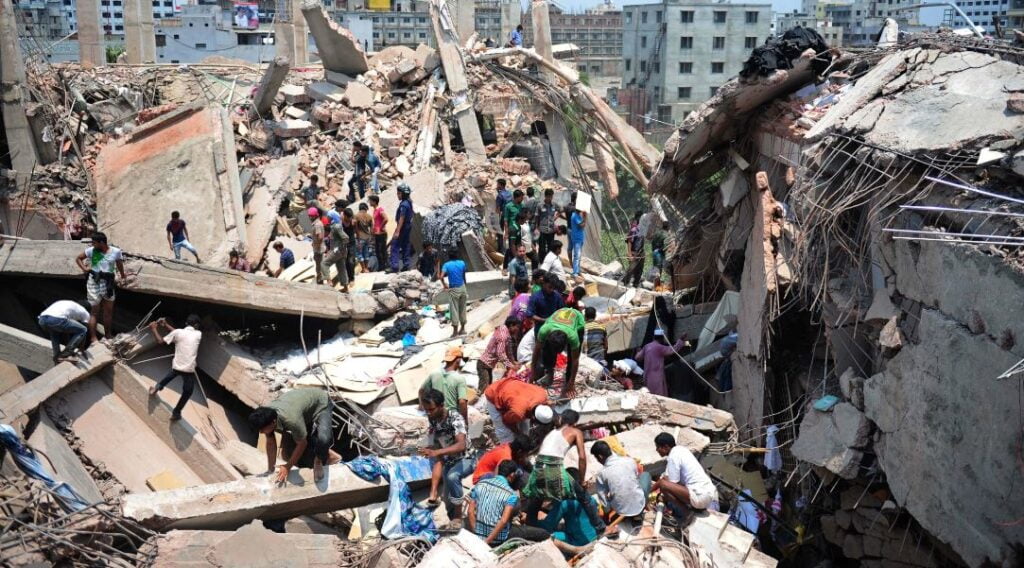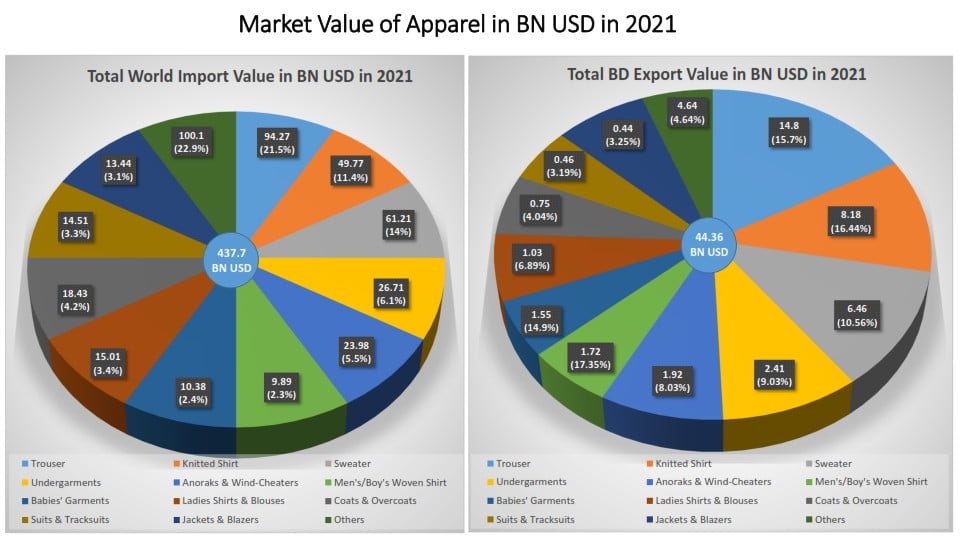Bangladesh’s garments industry has undergone a significant transformation in recent years, becoming one of the most important players in the global fashion scene. Today, the country has established itself as one of the major manufacturers of clothing, particularly for export to developed countries such as the United States and Europe. Not only has the industry played a vital role in boosting Bangladesh’s economy, but it has also become a key contributor to the country’s GDP, providing employment opportunities for approximately four million people.
The importance of the garments industry in Bangladesh cannot be overstated. The industry has grown rapidly, with exports increasing by more than six times in the past two decades. In 2020, the garment industry accounted for approximately 84% of Bangladesh’s total exports, making it a vital contributor to the country’s economy. It is the largest employer in the country, providing jobs for millions of people, particularly women.
However, the industry has also faced criticism for poor working conditions and labor rights violations. The collapse of the Rana Plaza factory in 2013, which killed over 1,000 people, brought international attention to the issue of worker safety in Bangladesh’s garment industry. Despite these challenges, the garments industry continues to be a vital part of Bangladesh’s economy and a major player in the global fashion scene. In this blog, we will explore the growth and development of Bangladesh’s garments industry, its impact on the global fashion scene, and the challenges facing the industry today.
Looking Back: Emergence of Bangladesh’s Garments Industry
The inception of the RMG Industry in Bangladesh

The ready-made garment (RMG) industry in Bangladesh can trace its origins back to the 1970s when a small number of entrepreneurs began exporting simple clothing items such as shirts and pants to international markets. At the time, Bangladesh was still recovering from the devastation of the 1971 war of independence, and it was in dire need of foreign currency to fund its development. The RMG industry provided that opportunity and quickly gained traction.
In the early years, the industry was primarily focused on exporting low-cost, low-quality products to developed countries such as the US and Europe. However, as the industry grew, so did export and the quality of the products being produced.
A Decade of Growth: 1980 – 1990
The RMG industry in Bangladesh experienced significant growth during the 1980s and 1990s. This period marked a turning point for the industry as it moved away from solely producing low-cost, low-quality products and began to focus on producing higher-quality garments for international markets.
One of the main drivers of this growth was the increased demand for garments from the existing consumer countries such as the United States and Europe. As consumer tastes and preferences shifted towards more casual, comfortable clothing, the RMG industry in Bangladesh was well-positioned to take advantage of this trend. Bangladesh’s relatively low labor costs and abundance of skilled labor further made it an attractive destination for international buyers looking for affordable, high-quality garments.
The Aftermath of the Rana Plaza Tragedy in 2013

The 2012 Tazreen factory fire and the 2013 Rana Plaza factory collapse brought serious international attention to the poor working conditions in the Bangladesh garments industry. The collapse, which killed over eleven hundred workers, was a tragic reminder of the human cost of the industry’s rapid growth and lack of regulation. At a more serious level, many international buyers stopped sourcing from Bangladesh during the aftermath of these incidents, and the US, which is one of the main consumers of this market, withdrew its preferential tariff agreement.
In response, the Bangladesh Government along with international corporations like International Labor Organization (ILO) and International Finance Corporation (IFC) finally took some steps to improve working conditions and safety standards in the industry. Many international brands and retailers also formally signed the Bangladesh Accord on Fire and Building Safety, which is a legally binding agreement to improve safety standards in the industry.
Impact on the Global Fashion Scene

According to data from the Bangladesh Export Promotion Bureau, in 2019, Bangladesh exported apparel worth $34.13 billion. This represents the significance of export which is primarily due to the growing number of international fashion brands that are sourcing from Bangladesh. This can also be seen as a testament to the country’s ability to produce high-quality garments at a low cost.
In light of the 12 segments of RMG, it is possible to get a comprehensive analysis of the current global market position of the industry. For example, the entire market size of the trouser segment in 2021 was $94.27 billion, where, Bangladesh occupied 15.70% of the market worth $14.80 billion. In the category of knitted shirts, Bangladesh had a 16.44% share worth $8.18 billion of a total market size of $49.77 billion. And for the sweater manufacturer in Bangladesh, with an export worth $6.46 billion, Bangladesh held 10.56% of a market of $61.21 billion.
Bangladesh’s garments industry has seen significant growth in exports to major markets, particularly the US and EU, due to a number of factors including low labor costs, government support, and the growing number of skilled workers in the industry. According to data from the same Bureau as cited earlier, exports of clothing and textiles from Bangladesh to the US grew by 8.5% in 2019, reaching a total of $6.5 billion whereas exports to the EU grew by 7.5% in 2019, reaching a total of $5.5 billion. These numbers demonstrate the growing importance of Bangladesh as a major player in the global fashion industry.
The number of international fashion brands sourcing from Bangladesh has also increased. Many well-known international fashion brands such as H&M, Zara, and Uniqlo are now sourcing from Bangladesh. These brands recognize the benefits of sourcing from Bangladesh such as low labor costs, which allow them to produce garments at a lower cost while producing garments of high quality and thus keeping up with the current ultra-fast fashion trend of the garments and textile industry.
Factor-Wise Analysis of the Existing Challenges in the Industry
Bangladesh’s garments industry is one of the most important sectors of the country’s economy, accounting for over eighty percent of the country’s total export revenues. However, despite its success, the industry faces a number of factors challenging its growth and development of the industry. A factor-wise analysis of those existing challenges and the Bangladesh RMG industry’s stance on those challenges has been presented below:
Coronavirus Pandemic
The RMG industry and wholesale clothing in Bangladesh got severely hampered by the pandemic where the exports fell by 17 percent only in the first year of the pandemic, representing revenue losses of up to $5.6 billion. The aftermath impacted the small operators lacking financial security and management capability, which consisted of the majority of the garments industry of the country. However, Bangladesh quickly bounced back by exporting apparel worth USD 3.8 billion in December 2021, following the global economic lockdown by surpassing the previous record of USD 33.07 billion set in 2019.

Infrastructure and Technology
There is a dearth of investment in the infrastructure of this industry. With the fast-evolving pace of the industry, it is not possible for Bangladesh to compete with its global comparative advantage of low labor-intensive productivity anymore. In order for the RMG industry to prosper, not only infrastructural investment is needed but also digitization of those infrastructures is also necessary. Thus, there is no alternative to adapting to improved technology across the industry functions in the current market for higher efficiency.
Sustainability
With increasing awareness about climate change and its environmental impacts, sustainability is becoming a more and more important factor for the apparel sourcing companies in Bangladesh with increasing consumer demand for environmentally friendly products. Although Bangladesh ranked only 87 out of 115 countries in the World Economic Forum’s Energy Transition Index in 2020, the industry is working towards becoming climate-neutral. With initiatives like the Circular Fashion Partnership, which is a multi-stakeholder initiative aiming to scale up the recycling of production waste, Bangladesh is gradually progressing to overcome this barrier. Furthermore,
around 1,500 companies from Bangladesh are currently certified by the Global Organic Textile Standard, which is the second-highest number globally.
Global Shift in Fashion

The global fashion industry is also constantly shifting which is continuously threatening Bangladesh’s position in industry supply chains. While Bangladesh’s Ready-Made Garment Solution from Bangladesh remains a strong exporter to its existing markets, this trend may not continue in the future. For example, Vietnam has outpaced Bangladesh in the US market for some time and now with the new preferential trade agreement between the European Union (EU) and Vietnam, apparel export from Vietnam could easily be outperforming Bangladesh’s in the European market as well.
The problem in this scenario is that the apparel export basket of Bangladesh has always been concentrated and unexplored in terms of product, fiber, and market destination. The global apparel industry is currently flourishing following a cost-saving model. With its transition from the cost-based model to what is being called “fast fashion”, it is being possible to generate inexpensive and trendy apparel made and sold in the market within record times. Thus the smart thing to do for the Bangladesh RMG industry in the current market scenario is to shift from the cost-based model to a shorter lead time rather than focusing on the current volume-driven growth strategy which is ultimately resulting in limited product diversification.
Ethical Production
With the increasing consumer demand for sustainable and ethically-made clothing, it is safe to say that the future growth potential for the industry lies in this sector.
However, one of the biggest challenges currently being faced by the garments industry in Bangladesh are labor rights and worker safety issues. Bangladesh has a history of poor working conditions and labor rights violations in its factories, with the collapse of the Rana Plaza factory in 2013, which killed over eleven hundred workers, being a tragic example. In an effort to improve these working conditions, measures including the implementation of new labor laws and the creation of inspection and monitoring programs have been taken. Other initiatives that started in the wake of the disasters, like the Accord on Fire and Building Safety in Bangladesh, the Alliance for Bangladesh Worker Safety, and the RMG Sustainability Council, further established Bangladesh’s RMG sector as a leader in transparency regarding factory safety and value-chain responsibility.
The gender gap and worker empowerment have also been big problems in this sector. The workers in the garments industry of Bangladesh are often paid low wages, with the minimum wage being $96 per month in 2021 which is considered below the poverty line. However, the digitization of wage payments in this sector is gradually growing and employment rights are also significantly improving with time.
The impact of ethical production in any industry is severe in consideration of the environmentally conscious consumers of the current market. The Bangladesh Garments Industry actually has a headstart here considering it came second in “Ethical Manufacturing” with a score of 7.7, trailing only Taiwan, which received an 8.0, according to the most recent survey report from Hong Kong-based supply chain compliance solutions supplier QIMA. After Thailand, Pakistan, Turkey, China, India, and Brazil, Vietnam came in third place. Although it is still contributing 0.45% of the world’s GHG emissions, Bangladesh is working on lessening that number with more and more factories going green at present.
Looking Ahead: What Lies in the Future of the Industry?
Despite all the challenges faced by the garments industry of Bangladesh in recent times, it has played a significant role in transforming the global fashion scene nonetheless. The country’s vast pool of skilled labor, competitive wages, and favorable government policies have continuously helped to make it a major player in the global garments market.
While Bangladesh is anticipated to move away from its primary competitive advantage of cheap labor by implementing automation at various production phases, it is gradually advancing toward a manufacturing technique with a better level of value added. Over the past ten years, Bangladesh’s RMG industry has been slowly moving to increasingly complicated products and value-added services while diversifying the client base of countries. This has been a significant strategy for the sector’s growth as well.
Looking to the future, there is the significant growth potential for the industry, especially with increasing consumer demand for sustainable and ethically-made clothing. With the growing
global emphasis on sustainability and ethical production, Bangladesh’s garments industry is well-positioned to capitalize on this trend and continue to grow in the coming years. However in order to survive in the longer run, the industry will need to constantly advance, modernize, and diversify while investing in infrastructure, adaptability, sustainability, and worker welfare. It will need to be able to compete without exclusive trade access and fulfill dwindling client market demand while going through a fundamental transition.
In conclusion, Bangladesh’s garments industry has already made a significant impact on the global fashion scene and it has a potential for further growth in the future. And with the right policies and investments, Bangladesh could continue to be a major player in the global fashion industry for many years to come.
FAQs
What are the main export markets for Bangladesh’s garments industry?
Bangladesh’s garments industry exports primarily to the US and EU, with the US being the largest market, accounting for around 60% of total exports. Other significant markets include Germany, UK, France, and Italy.
What are some of the challenges facing the garments industry in Bangladesh?
The garments industry in Bangladesh faces challenges such as low wages, limited worker rights, and poor working conditions. The industry also faces pressure to improve sustainability and reduce its environmental impact. Additionally, there are concerns about the lack of compliance with labor laws and the need for investment in technology and infrastructure.
What are some of the major brands and retailers that source garments from Bangladesh?
Major brands and retailers sourcing garments from Bangladesh include H&M, Walmart, Gap, Zara, and Target. Other brands include C&A, Levi’s, Tommy Hilfiger, and Puma. These companies source from Bangladesh due to its large pool of low-wage workers and favorable government policies.
How big is the clothing industry in Bangladesh?
The clothing industry in Bangladesh is one of the largest in the world, employing over 4 million people and contributing to over 80% of the country’s total exports. The industry is valued at around $40 billion and continues to grow, making it a significant player in the global fashion and textile market.
How is the RMG sector in Bangladesh being improved?
The RMG (Ready-Made Garment) sector in Bangladesh is being improved through various initiatives, such as the implementation of labor and environmental laws, investment in technology and infrastructure, and efforts to improve working conditions and increase sustainability. Additionally, partnerships with international organizations and brands are helping to bring about positive change in the industry.
References: